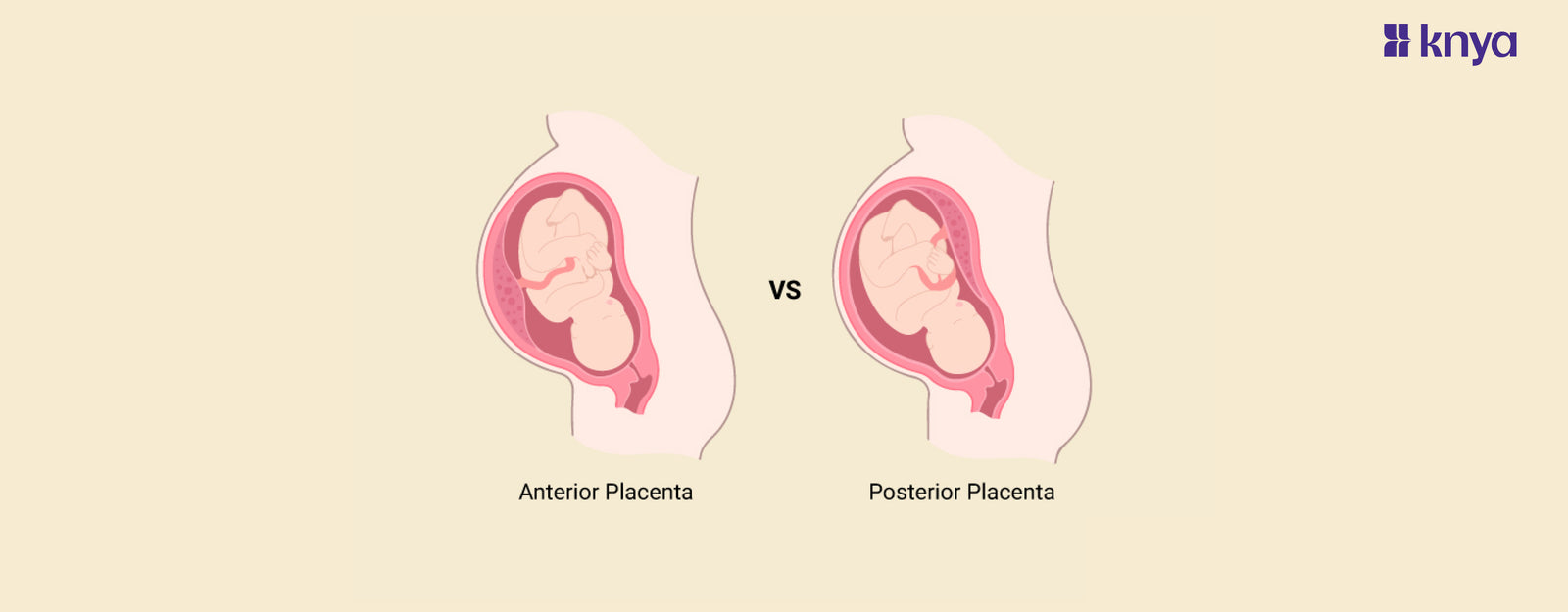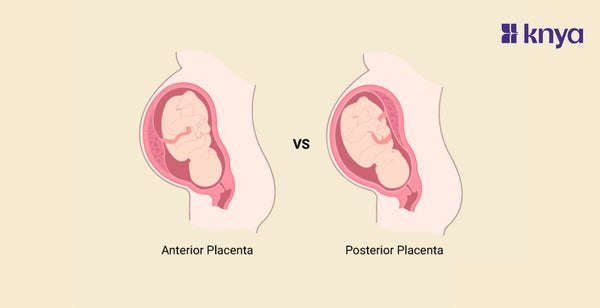Difference Between Anterior and Posterior Placenta: The placenta, a vital organ during pregnancy, plays a crucial role in supporting fetal development. Its location within the uterine wall can vary, leading to distinctions between an anterior and posterior placenta. Understanding the differences between these placements is significant for monitoring maternal health and fetal well-being. Here's a difference between overview:
Difference Between Anterior and Posterior Placenta
Here's a table summarizing the key differences between anterior and posterior placenta for a better understanding
|
Characteristic |
Anterior Placenta |
Posterior Placenta |
|
Location in the Uterus |
Positioned on the front wall of the uterus |
Located on the back wall of the uterus |
|
Effect on Fetal Movements |
Movements may be perceived as less noticeable externally due to the placental cushioning effect |
Movements are often more palpable and noticeable externally |
|
Sensations during Pregnancy |
Kicks and movements may be felt more internally or later in the pregnancy |
Pronounced movements may be felt earlier in the pregnancy, sometimes visible from the outside |
|
Ultrasound Visualization |
May pose challenges in visualizing certain aspects of the fetus during ultrasounds |
Generally provides clearer visibility of the fetus during ultrasounds |
|
Impact on Labor and Delivery |
Minimal impact on the progress of labor and delivery |
Generally does not significantly influence the labor process |
|
Placental Thickness |
May have variable thickness; may be thicker in some cases |
Typically has more consistent thickness |
|
Positional Variability |
May affect the baby's position in certain cases |
Generally has less impact on fetal positioning |
|
Maternal Perception |
Mothers might feel movements more internally or deeply |
Mothers often feel distinct movements closer to the surface |
|
Risk of Placenta Previa |
Slightly increased risk of anterior placenta causing placenta previa |
Usually, posterior placenta has a lower risk of causing placenta previa |
|
Challenges in Monitoring |
Monitoring certain fetal parameters may be challenging |
Monitoring is often more straightforward due to better visibility |
|
Frequency of Occurrence |
Relatively common, with about half of pregnancies having an anterior placenta |
Also common, occurring in about half of pregnancies |
Shop the best Lab Coats from Here!
What is the Anterior Placenta?
The anterior placenta refers to the location of the placenta within the uterus, specifically on the front wall of the uterus, facing the abdominal wall of the pregnant woman. The placenta is a temporary organ that develops during pregnancy and plays a crucial role in supporting fetal growth and development.
Key Points about Anterior Placenta:
- Location: The anterior placenta is situated on the side of the uterus that is closest to the abdominal wall and may be in proximity to the front of the mother's belly.
- Effect on Fetal Movements: Due to its location, the anterior placenta may act as a cushion, potentially making fetal movements less noticeable externally. This is because the placenta serves as a barrier between the baby's movements and the mother's abdominal wall.
- Ultrasound Visualization: Visualizing certain aspects of the fetus during ultrasounds may be more challenging when the placenta is anterior. However, advancements in ultrasound technology generally allow healthcare providers to obtain comprehensive images.
- Maternal Perception: Mothers with an anterior placenta may feel fetal movements more internally or deeply before these movements become externally palpable.
- Placental Thickness: The thickness of the anterior placenta can vary, and in some cases, it may be thicker compared to other locations within the uterus.
- Risk of Placenta Previa: There is a slightly increased risk of the anterior placenta causing placenta previa, a condition where the placenta partially or completely covers the cervix.
It's important to note that having an anterior placenta is a normal variation and does not necessarily indicate any health issues for the mother or baby. Healthcare providers monitor the placental position during prenatal care to ensure the well-being of both the mother and the developing fetus.
What is the Posterior Placenta?
The posterior placenta refers to the location of the placenta within the uterus, specifically on the back wall of the uterus, closer to the spine of the pregnant woman. Like the anterior placenta, the posterior placenta is a temporary organ that develops during pregnancy and plays a crucial role in supporting fetal growth and development.
Key Points about Posterior Placenta:
- Location: The posterior placenta is situated on the side of the uterus that is closer to the mother's back and spine.
- Effect on Fetal Movements: Fetal movements may be more noticeable externally when the placenta is posterior, as there is less tissue, and the movements are not as cushioned. Mothers often feel distinct movements closer to the surface.
- Ultrasound Visualization: Generally, visualizing certain aspects of the fetus during ultrasounds is more straightforward when the placenta is posterior.
- Maternal Perception: Mothers with a posterior placenta may experience more pronounced and palpable fetal movements earlier in the pregnancy.
- Placental Thickness: The thickness of the posterior placenta is typically more consistent compared to an anterior placenta.
- Risk of Placenta Previa: Posterior placenta is associated with a lower risk of causing placenta previa, a condition where the placenta partially or completely covers the cervix.
Having a posterior placenta is considered a normal variation in placental placement, and it does not necessarily indicate any health issues for the mother or baby. Healthcare providers monitor the placental position during prenatal care to ensure the well-being of both the mother and the developing fetus.
Similarity Between Anterior and Posterior Placenta
While anterior and posterior placentas are located on different walls of the uterus, they share some similarities in their overall functions and significance during pregnancy. Here are the commonalities between anterior and posterior placentas:
- Vital Role in Fetal Development:
- Both anterior and posterior placentas play a crucial role in supporting fetal growth and development during pregnancy.
- Nutrient and Oxygen Exchange:
- Both types of placentas facilitate the exchange of nutrients, oxygen, and waste products between the mother's bloodstream and the developing fetus.
- Hormone Production:
- Anterior and posterior placentas are involved in hormone production, releasing essential hormones such as human chorionic gonadotropin (hCG), progesterone, and estrogen to maintain pregnancy and support fetal development.
- Protection of Fetus:
- Both placentas act as a protective barrier, preventing harmful substances from reaching the fetus while allowing beneficial nutrients to pass through.
- Attachment to Uterine Wall:
- Anterior and posterior placentas attach to the uterine wall, ensuring stability and proper positioning to provide optimal support for the fetus.
- Monitoring during Prenatal Care:
- Healthcare providers monitor the position and health of both anterior and posterior placentas during routine prenatal care to assess the well-being of the pregnancy.
- Dynamic Organ:
- Both placentas undergo dynamic changes throughout pregnancy, adapting to the evolving needs of the developing fetus.
- Temporary Nature:
- Anterior and posterior placentas are temporary organs that are expelled from the body after childbirth.
While their locations within the uterus differ, the shared functions of anterior and posterior placentas underscore their critical roles in ensuring a healthy pregnancy and fetal development. Both types of placentas contribute to the well-being of the mother and the growing fetus by facilitating the exchange of essential substances and providing a protective environment.
|
Check out More Articles |
|















